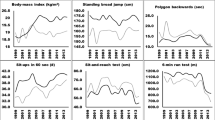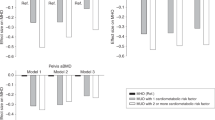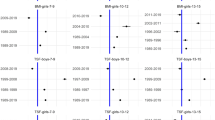Abstract
Objective:
To evaluate physical fitness and body composition of children involved in the ‘Québec en Forme’ (QEF) Project and to compare data obtained to the reference values of the 1981 Canada Fitness Survey (CFS).
Design:
Cross-sectional study.
Subjects:
A total of 1140 children (591 boys and 549 girls) of first (7 years), second (8 years) and fourth (10 years) grade from primary schools in the City of Trois-Rivières (Québec) were selected to participate in this study.
Measurements:
Body mass index (BMI) and waist circumference (WC) were measured. The physical fitness tests included standing long jump, 1-min speed sit-ups and speed shuttle run.
Results:
The prevalence of overweight in children ranged between 20 and 30%, which represents a substantial increase compared to the 1981 CFS. The relationship between BMI and WC was highly significant in boys and girls (r=0.90 and 0.86, respectively, P<0.0001). The negative correlations between BMI or WC and the performance in all physical fitness tests were mostly significant in children of both genders (−0.16⩽r⩽−0.45, at least P<0.05), and these relationships were significantly greater in older children (P<0.05). Based on the 1981 CFS, only 4.7–14.1% of QEF boys still performed in the upper quartile of the distribution (fit boys), whereas 32.1–69% performed not much higher than the lower quartile (unfit boys) for each fitness test. In girls, the relative fitness decrease observed in 2003 was more pronounced since only 1–9.9% of subjects performed in the upper quartile of the distribution compared to 42.8–81.4% who did not perform higher than the lower quartile of the 1981 reference scores of the CFS.
Conclusion:
This study shows that BMI and WC are negatively correlated with physical fitness and that these associations are more pronounced in older children. Furthermore, physical fitness of our cohort, especially in girls, was much lower than what was documented in the 1981 CFS in subjects of the same age. This study thus emphasizes the necessity to develop early interventions to improve physical fitness in children and to prevent the increase of childhood obesity.
This is a preview of subscription content, access via your institution
Access options
Subscribe to this journal
Receive 12 print issues and online access
$259.00 per year
only $21.58 per issue
Buy this article
- Purchase on Springer Link
- Instant access to full article PDF
Prices may be subject to local taxes which are calculated during checkout




Similar content being viewed by others
References
Lobstein T, Baur L, Uauy R . Obesity in children and young people: a crisis in public health. Obes Rev 2004; 5 (Suppl 1): 4–85.
Tremblay MS, Katzmarzyk PT, Willms JD . Temporal trends in overweight and obesity in Canada, 1981–1996. Int J Obes Relat Metab Disord 2002; 26: 538–543.
Freedman DS, Khan LK, Dietz WH, Srinivasan SR, Berenson GS . Relationship of childhood obesity to coronary heart disease risk factors in adulthood: the Bogalusa Heart Study. Pediatrics 2001; 108: 712–718.
Power C, Lake JK, Cole TJ . Body mass index and height from childhood to adulthood in the 1958 British born cohort. Am J Clin Nutr 1997; 66: 1094–1101.
Guo SS, Roche AF, Chumlea WC, Gardner JD, Siervogel RM . The predictive value of childhood body mass index values for overweight at age 35 y. Am J Clin Nutr 1994; 59: 810–819.
Serdula MK, Ivery D, Coates RJ, Freedman DS, Williamson DF, Byers T . Do obese children become obese adults? A review of the literature. Prev Med 1993; 22: 167–177.
Must A, Jacques PF, Dallal GE, Bajema CJ, Dietz WH . Long-term morbidity and mortality of overweight adolescents. A follow-up of the Harvard Growth Study of 1922 to 1935. N Engl J Med 1992; 327: 1350–1355.
Must A, Strauss RS . Risks and consequences of childhood and adolescent obesity. Int J Obes Relat Metab Disord 1999; 23 (Suppl 2): S2–S11.
Gutin B, Basch C, Shea S, Contento I, DeLozier M, Rips J et al. Blood pressure, fitness, and fatness in 5- and 6-year-old children. JAMA 1990; 264: 1123–1127.
Stewart KJ, Brown CS, Hickey CM, McFarland LD, Weinhofer JJ, Gottlieb SH . Physical fitness, physical activity, and fatness in relation to blood pressure and lipids in preadolescent children. Results from the FRESH Study. J Cardiopulm Rehab 1995; 15: 122–129.
Perry AC, Tremblay LM, Signorile JF, Kaplan TA, Miller PC . Fitness, diet and coronary risk factors in a sample of southeastern US children. Appl Hum Sci 1997; 16: 133–141.
Rump P, Verstappen F, Gerver WJ, Hornstra G . Body composition and cardiorespiratory fitness indicators in prepubescent boys and girls. Int J Sports Med 2002; 23: 50–54.
Johnson MS, Figueroa-Colon R, Herd SL, Fields DA, Sun M, Hunter GR et al. Aerobic fitness, not energy expenditure, influences subsequent increase in adiposity in black and white children. Pediatrics 2000; 106: E50.
Janz KF, Dawson JD, Mahoney LT . Increases in physical fitness during childhood improve cardiovascular health during adolescence: the Muscatine Study. Int J Sports Med 2002; 23 (Suppl 1): S15–S21.
Cole TJ, Bellizzi MC, Flegal KM, Dietz WH . Establishing a standard definition for child overweight and obesity worldwide: international survey. BMJ 2000; 320: 1240–1243.
Canadian Association for Health Physical Education and Recreation, CAHPER. Fitness Performance II, Test Manual. The Canadian Association for Health, Physical Education and Recreation, 1980.
Snedecor GW, Cochran WG . Statistical Methods, 6th edn, Iowa State University Press: Ames, IA, 1967.
Malina RM, Beunen GP, Classens AL, Lefevre J, Vanden Eynde BV, Renson R et al. Fatness and physical fitness of girls 7 to 17 years. Obes Res 1995; 3: 221–231.
Okely AD, Booth ML, Chey T . Relationships between body composition and fundamental movement skills among children and adolescents. Res Q Exerc Sport 2004; 75: 238–247.
Grund A, Dilba B, Forberger K, Krause H, Siewers M, Rieckert H et al. Relationships between physical activity, physical fitness, muscle strength and nutritional state in 5- to 11-year-old children. Eur J Appl Physiol 2000; 82: 425–438.
Chatrath R, Shenoy R, Serratto M, Thoele DG . Physical fitness of urban American children. Pediatr Cardiol 2002; 23: 608–612.
Gray A, Smith C . Fitness, dietary intake, and body mass index in urban Native American youth. J Am Diet Assoc 2003; 103: 1187–1191.
Norman AC, Drinkard B, McDuffie JR, Ghorbani S, Yanoff LB, Yanovski JA . Influence of excess adiposity on exercise fitness and performance in overweight children and adolescents. Pediatrics 2005; 115: e690–e696.
Ara I, Vicente-Rodriguez G, Jimenez-Ramirez J, Dorado C, Serrana-Sanchez JA, Calbet JA . Regular participation in sports is associated with enhanced physical fitness and lower fat mass in prepubertal boys. Int J Obes Relat Metab Disord 2004; 28: 1585–1593.
Guerra S, Ribeiro JC, Costa R, Duarte J, Mota J . Relationship between cardiorespiratory fitness, body composition and blood pressure in school children. J Sports Med Phys Fitness 2002; 42: 207–213.
Pongprapai S, Mo-suwan L, Leelasamran W . Physical fitness of obese school children in Hat Yai, southern Thailand. Southeast Asian J Trop Med Public Health 1994; 25: 354–360.
Bettiol H, Rona RJ, Chinn S . Variation in physical fitness between ethnic groups in nine year olds. Int J Epidemiol 1999; 28: 281–286.
Deforche B, Lefevre J, De Bourdeaudhuij I, Hills AP, Duquet W, Bouckaert J . Physical fitness and physical activity in obese and nonobese Flemish youth. Obes Res 2003; 11: 434–441.
Wedderkopp N, Froberg K, Hansen HS, Andersen LB . Secular trends in physical fitness and obesity in Danish 9-year-old girls and boys: Odense School Child Study and Danish substudy of the European Youth Heart Study. Scand J Med Sci Sports 2004; 14: 150–155.
Przeweda R, Dobosz J . Growth and physical fitness of Polish youths in two successive decades. J Sports Med Phys Fitness 2003; 43: 465–474.
Tremblay A, Chiasson L . Physical fitness in young college men and women. Can J Appl Physiol 2002; 27: 563–574.
Whitaker RC, Wright JA, Pepe MS, Seidel KD, Dietz WH . Predicting obesity in young adulthood from childhood and parental obesity. N Engl J Med 1997; 337: 869–873.
Magarey AM, Daniels LA, Boulton TJ, Cockington RA . Predicting obesity in early adulthood from childhood and parental obesity. Int J Obes Relat Metab Disord 2003; 27: 505–513.
Acknowledgements
This study was supported by grants from the Lucie and André Chagnon Foundation and the Government of the Province of Québec.
Author information
Authors and Affiliations
Corresponding author
Rights and permissions
About this article
Cite this article
Brunet, M., Chaput, JP. & Tremblay, A. The association between low physical fitness and high body mass index or waist circumference is increasing with age in children: the ‘Québec en Forme’ Project. Int J Obes 31, 637–643 (2007). https://doi.org/10.1038/sj.ijo.0803448
Received:
Revised:
Accepted:
Published:
Issue Date:
DOI: https://doi.org/10.1038/sj.ijo.0803448
Keywords
This article is cited by
-
Relationship between breakfast consumption, BMI status and physical fitness of Ghanaian school-aged children
BMC Nutrition (2020)
-
Physical fitness and anthropometric characteristics among adolescents living in urban or rural areas of Kosovo
BMC Public Health (2017)
-
Influence of physical fitness on cardio-metabolic risk factors in European children. The IDEFICS study
International Journal of Obesity (2016)
-
Fitness level and body composition indices: cross-sectional study among Malaysian adolescent
BMC Public Health (2014)
-
Level of physical activity and anthropometric characteristics in old age—results from a national health survey
European Review of Aging and Physical Activity (2014)



